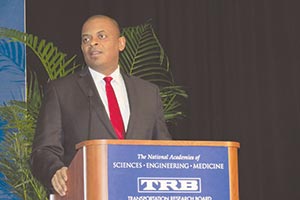Anthony Foxx Touts DOT Accomplishments, Unveils Final Transport Road Map

This story appears in the Jan. 16 print edition of Transport Topics.
WASHINGTON — Outgoing Transportation Secretary Anthony Foxx emphasized the importance of freight movement during a final address to the transportation community Jan. 9.
Speaking at the annual meeting of the Transportation Research Board here, Foxx said if people were capable of reducing freight bottlenecks, which “cut off our ability to create jobs, you’d do something about it and not wait. Building [transportation] choices is not just a strategy for individuals’ mobility, it’s also a freight strategy.”
That strategy entails pushing more longhaul trips onto highways and rail, part of what Foxx termed “our critical freight systems” and off local roads. He also mentioned extending fuel-efficiency standards for medium- and heavy-duty vehicles.
“I want to thank Congress for recognizing the importance of freight by … including in the FAST Act a freight program that we now call the FASTLANE program,” Foxx said, adding that a multimodal approach will be necessary to build an integrated transportation system.
Foxx used his farewell address at TRB to note that USDOT has accomplished the seven ambitious goals he outlined in his first speech at the annual meeting in 2014.
“When the history gets written about this period of time, it [will be seen as] the beginning of a massive transformation [of] how we begin to think about our transportation system,” said Foxx, who continually put on and took off his glasses during his half-hour of remarks. “Are we better off today than we were four years ago? The answer is yes.”
The seven goals: the passage of a new surface transportation bill; improving the NextGen air traffic control system; expanding public- private partnerships in transportation; closing opportunity gaps for disadvantaged communities; outlining a 30-year transportation plan; placing a greater emphasis on the safety of bicyclists and pedestrians; and embracing technology.
Foxx said many wondered if he was “giving the department and the system indigestion” by trying to do so much so quickly. And yet, as he noted, with the exception of NextGen, which he said is “on a path to happen,” the rest of the goals have been achieved.
Among those are the FAST Act becoming law, the Build America Bureau, a one-stop shop for public-private partnerships being established within USDOT and setting what he called the world’s first national policy for autonomous vehicles. But Foxx’s proudest accomplishment is Beyond Traffic, that 30-year look ahead whose final version was released as he spoke at TRB.
“Our nation is changing rapidly, and if our transportation system doesn’t adjust, we, as a nation, will be stuck in traffic,” Foxx said. “This report raises the question … how do we get beyond traffic? We need to close the cognitive dissonance between what we know from data and how we actually behave in practice and in policy.”
Among that data Foxx cited, Beyond Traffic predicts that the nation’s population will grow by 70 million to 390 million by 2045, while large trucks will transport goods 16.5 billion miles compared with 11.5 billion today.
In warning about the dangers of “continuing to chronically underinvest in infrastructure,” Foxx called Beyond Traffic, “our gift to the country, a path forward.”

